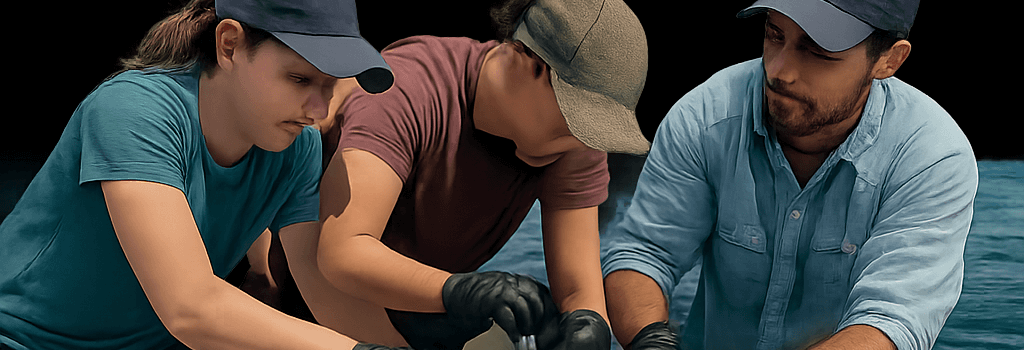Shark Tagging: A Technical Dive with the Field School

In July 2025, a team of ocean science enthusiasts, students, and professionals gathered aboard the research vessel Garvin in Biscayne Bay to experience shark tagging firsthand. What began as a refurbished dive boat and a mission framed by a single Post it note reading “no assholes” has grown into the Field School for Marine Science and Technology, a startup blending hands-on training, cutting-edge instrumentation, and inclusive culture to democratize ocean research.
I. The Evolution of the Field School and the RV Garvin
Origins and Mission No Assholes Culture
In 2019 the University of Miami PhD candidate Catherine MacDonald and her colleagues recognized that traditional field science often suffered from toxic hierarchies and barriers to entry. Inspired by a shared belief that rigorous research and supportive mentorship go hand in hand, they scrawled “no assholes” on a Post it as a guiding principle. Today that motto sits framed in the Field School office as a reminder that kindness accelerates scientific discovery.
Refurbishing a Dive Boat into a Certified Research Vessel
The Garvin began life as a coastal dive boat. After its owner passed, MacDonald and team leveraged personal loans and seed funding from friends and family to acquire it. Over six months they performed hull surveys and structural retrofits, learned fiberglass repair, installed a new custom stainless steel fuel tank, and upgraded navigation electronics to meet US Coast Guard research vessel certifications. A waterproof GNSS receiver now logs position with submeter accuracy, and a commercial AIS transponder ensures collision avoidance in busy waterways.
II. The Drum Line Tagging Protocol
Equipment Specifications and Deployment
The Field School uses drum lines configured with a 16 kilogram coated steel weight, a 20 centimeter float to maintain buoyancy, and 800 pound monofilament test line rated to withstand over 360 kilograms of force. Hooks conform to circle hook designs to reduce gut hooking and facilitate safe release. Deployment follows a precision choreography: GPS waypoint logging, careful rope handling to avoid entanglement, and timestamped records for later data synchronization.
Live Bait Attraction and Safety Mechanisms
To attract sharks, each float carries a perforated stainless steel bait cage containing fish offal that continuously releases amino acid odorants into the water. Quick-release shackles and breakaway line segments serve as emergency mechanisms should the hooked animal exert excessive force, protecting both researchers and the marine environment.
III. Onboard Data Collection and Biosampling
Measurement Tissue and Blood Sampling
Once a shark approaches the drum line, crew members use manual spools and guide rods to land the animal alongside a rigid boarding platform. A team measures total length, fork length, and pre-caudal length to millimeter precision using digital calipers and laser rangefinders. Parasites are sampled with sterile forceps and preserved in 90 percent ethanol. Fin clips about 2 by 3 millimeters are taken for genomic analysis, while 5 milliliters of blood are drawn into heparinized syringes and processed in a portable benchtop centrifuge at 3,000 rpm to separate plasma for hormone assays.
Tagging Technology Acoustic Satellite and PIT tags
Each shark receives a dual tagging approach. A subdermal passive integrated transponder or PIT tag provides a permanent unique code readable by handheld scanners. An acoustic transmitter emits coded pings detected by an array of stationary hydrophones now being expanded through NOAA’s Pacific Shark Tagging Consortium. For larger sharks, dorsal fin satellite tags record dive profiles and transmit summarized data to ARGOS satellites, enabling real-time monitoring of movements across the Gulf Stream.
IV. Data Management and Real Time Monitoring
Back onshore, raw field logs are digitized into a cloud-backed relational database. Custom Python scripts ingest GPS timestamps, tag IDs, and sample metadata. Automated pipelines align acoustic detections with environmental data feeds including sea surface temperature from Copernicus and chlorophyll concentrations from NASA’s MODIS satellite. This enables machine learning models to predict shark habitat preferences with over 85 percent accuracy, advancing conservation planning.
V. Conservation Outcomes and Policy Integration
Since 2023 the Field School has contributed to population assessments used by the Miami-Dade Marine Resources Division to inform seasonal fishing closures. Preliminary results published in Marine Ecology Progress Series show that blacktip shark residency times in Biscayne Bay average 45 days, underscoring the bay’s role as a pupping ground. Collaboration with the Florida Fish and Wildlife Conservation Commission has integrated these findings into new bycatch reduction gear regulations.
VI. Field School as a Biotech Focused Marine Science Startup
Operating on a mixed revenue model, the Field School charges full-fare for corporate team-building and educational charters while subsidizing seats for low-income students. By blending experiential marine biology with practical training in boat maintenance, data analytics, and genomics, the startup has attracted angel investment from environmental tech incubators and secured a National Science Foundation Innovations in Graduate Education grant to expand remote learning modules.
VII. Looking Forward AI and Robotics in Marine Tagging
Emerging technologies promise to further transform shark research. AI-driven image recognition on drone-captured footage is being piloted to detect dorsal fins and classify species in real time. Autonomous surface vessels equipped with echosounders and robotic arms may soon deploy and retrieve drum lines without human intervention, reducing risk and increasing sampling efficiency by up to 40 percent according to a recent MIT Lincoln Laboratory report.
VIII. Conclusion Democratizing Ocean Science through Hands On Research
Overall the most important outcome is demonstrating that field science can be rigorous, inclusive, and innovative simultaneously
The Field School and its refurbished RV Garvin represent a new model for marine research education. By equipping participants with the tools, skills, and culture to conduct high-quality field science, this startup is not just tagging sharks—it is tagging the future of ocean conservation with empathy, technology, and community.